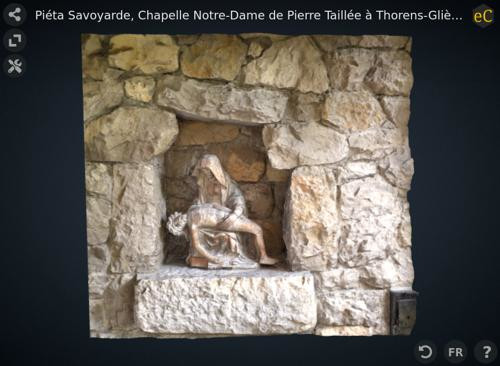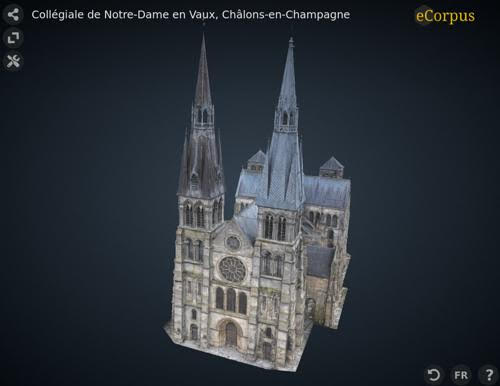A Digital Museum for a Dispersed Heritage
The community of municipalities of Filière, in Haute-Savoie, has launched a digital museum project to showcase local heritage using eCorpus. As part of this initiative, several artifacts located in the surrounding villages have been scanned. Notable examples include a statue of Saint Sebastian in the church of Thorens-Glières and a Virgin of Pity in a mountain chapel. The digital museum will promote the richness of this often-overlooked heritage and will be accessible online as well as via a digital display in the Filière art gallery.

For eCorpus, this is an opportunity to explore interoperability with the POP (Plateforme Ouverte du Patrimoine) database, and more specifically the Palissy database, which catalogs movable heritage. Connecting databases is a crucial issue in heritage digitization. It enables the interdisciplinarity necessary for studying and preserving works that may lie at the crossroads of archaeological, physico-chemical, artistic, and geographical research.
Dynamic Levels of Detail
As promised, in this issue we take a closer look at dynamic levels of detail, the problems they address, and the process of creating such models.
The Challenge: Decorated CavesAmong the projects using eCorpus and Voyager, one of the most ambitious models in terms of scale is a model of the decorated Chauvet Cave for the "Grands Sites Archéologiques" collection of the Ministry of Culture. The Chauvet Cave comprises several chambers and contains a thousand paintings and engravings spread over approximately 9 hectares. These caves have been scanned, but the resulting models are extremely large due to the site’s size and the level of detail required to observe engravings, paintings, bear claw marks, and other features.
The problem is most pronounced for decorated caves but also applies to buildings, interiors, and large objects with very fine details. The challenge was therefore to determine how to make these models accessible to both the public and researchers.
Dynamic Levels of Detail (LOD) — What Are They?When loading 3D models, they contain textures describing the appearance of the surface. The more detailed these textures, the heavier the files become, demanding more from the user’s device.
The principle of dynamic levels of detail is to use multiple versions of the same 3D model at different resolutions and to load the most suitable one depending on what is displayed on screen (based on distance, angle, etc.).
The integration of dynamic levels of detail is a challenge we have been working on since last year and it has now been implemented in the latest version of dpo-voyager. It requires a specific algorithm to decide which quality level to load based on the user’s position and viewpoint. The goal is to display high-quality details when focusing on specific elements, while avoiding memory overload by not loading overly detailed textures unnecessarily.
Some ExamplesWith these new capabilities, it is now possible to explore large-scale models while still retaining readable details when zooming in on specific parts. You can try this new feature by viewing the Collegiate Church of Notre-Dame-en-Vaux in Châlons-en-Champagne:
 The Process of Creating Models
The Process of Creating Models
Producing a model for an LOD scene requires specific preparation. If a scene consists of a single 3D object, building, or environment, it must be divided into tiles for display purposes. For example, starting from a very high-resolution model with complex UDIM texture sets, as is often the case with photogrammetry, the mesh can be divided into tiles, each with its own optimized texture.
Different levels of detail are then generated for each tile from the original model. A Voyager scene is then created from the set of these sub-elements.
>If you would like to discuss LOD model creation, we invite you to join the following discourse thread: https://discourse.holusion.net. Our automation tools are still in development, but at minimum there is a Blender script available for generating tiled texture sets.
In the long term, we aim to simplify the creation of LOD models by integrating automated processing directly during import into eCorpus.
Summer Updates
Behind the scenes, we have changed the database used by eCorpus and reworked the search function. All texts within Voyager scenes (annotations, articles, etc.) are now included!
Scene creation and updates with zip files have also been slightly reworked to allow the upload of multiple zip archives containing scenes and/or glb files at the same time. It is now possible to overwrite an existing scene with a zip without being an administrator.
Back to School with eCorpus
This month, we are working to make eCorpus more suited to teaching and to improve the management of large numbers of models and users. To facilitate scene and user management, we plan to add the ability to edit tags, user rights, and archiving for multiple scenes at once directly from the search results page. We are also beginning work on user groups.